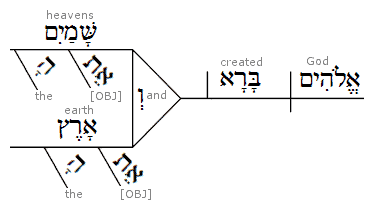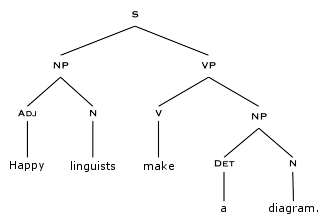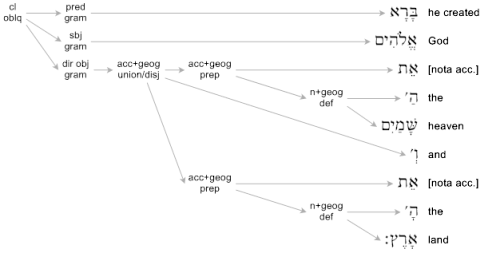Why did we choose graphs to represent syntax instead of something else? Short answer: Because.
The long answer, however, is much more interesting: Because every method of graphically showing the syntactic form of a sentence or clause has its pros and cons. Graphs have a lot of pros, and not many cons.
Reed-Kellogg Diagrams
PRO: They’re familiar. Lots of people grew up making traditional sentence diagrams in grade school. I know I did. (Full disclosure: I hated them, too.) Even though the details may change from usage to usage, these sorts of diagrams have been used for over a hundred years to display the parts of a sentence.
PRO: They’re rational. They dissect a sentence (or clause) into its constituent parts and then rearrange those parts in an orderly, logical representation. This, according to Reed & Kellogg, is a virtue:
The fact that the pictorial diagram groups the parts of a sentence according to their offices and relations, and not in the order of speech, has been spoken of as a fault. It is, on the contrary, a merit, for it teaches the pupil to look through the literary order and discover the logical order. He thus learns what the literary order really is, and sees that this may be varied indefinitely, so long as the logical relations are kept clear.
CON: They’re old. This method of diagramming, called Reed-Kellogg after its inventors, is over a hundred years old. They first appeared in An Elementary English Grammar in 1878. Theyre … well … um … theyre old-fashioned. When they were introduced, these diagrams represented the state of the art. That art, however, has since moved on to a new state. They’re also clearly designed for English (with a strong Latin influence), rather than for other languages.
CON: They’re too rational. They dissect a sentence (or clause) into its constituent parts and then rearrange those parts in an orderly, logical representation. A well-written sentence is more than the sum of its parts; each individual sentence has a personality all its own. However, dismembering the sentence this way makes the diagram more like an autopsy photo than a portrait. (Ick.)
CON: They’re experiential. That is, it seems to me that the exercise of making a Reed-Kellogg diagram from scratch is more valuable than the product. As Reed & Kellogg say, The diagram drives the pupil to a most searching examination of the sentence, brings him face to face with every difficulty, and compels a decision on every point. Once youve done that or had someone do it for you! youve experienced the main benefit of the diagram.
CON: They’re hard to draw programmatically. All those different shapes, combined in so many different ways. Computer programmers tend to like more abstract, repeatable structures. Like graphs.
CON: There just aren’t enough shapes. There are only so many ways you can write a dangling line, not nearly enough to account for all the novel structures in a language.
If you want to enjoy the benefits of the exercise of making a Reed-Kellogg diagram, then the Libronix DLS Sentence Diagramming Addin is a great tool for doing that.
Sentence-Flow Diagrams
Plenty of people show the syntax of a sentence by simply adding line breaks and indentions to show the relationships between phrases and clauses. For example, making such a diagram is one step in the exegetical how-to presented in Gordon D. Fees book, New Testament Exegesis.
There are a lot of pros to this approach: Sentence-flow diagrams keep the text in its natural order. They’re easy to understand. They expose rhetorical structure of a passage pretty quickly, and without a lot of hassle. Maybe most importantly, they preach, that is, they have value as homiletical help.
There’s only one con, but it’s a deal-breaker: This kind of presentation just loses too much information. There aren’t any labels, usually, and indention means different things in different contexts. Furthermore, these sorts of diagrams tend not to break the text down to a very fine level; if they did, then almost every word would be on its own line. When we look at syntax from a linguistic or even hermeneutical/interpretive standpoint, we want to know more than just the flow of the text; we want to label all the parts, and we want to know exactly what the relationships are. So, while sentence flow diagrams are useful for exegesis and for preparing sermons, they’re not as useful for marking up syntax.
The Libronix DLS Sentence Diagrammer supports sentence-flow diagrams as of version 2.2, which is currently in Alpha.
Trees
Many linguists use trees to mark syntactic data, like so:
A tree is just a specialized sort of graph, that is, its a diagram with lines and labels. (Trees also have a few additional restrictions, but lets not get into that just yet.) These are exactly the sort of diagrams that I had to make in the Linguistics 101 class I took in college. (Full disclosure: I didn’t like them much, either.)
PRO: They’re modern. If you draw a syntax tree instead of a Reed-Kellogg diagram, youve joined the twentieth century. They do have a sort of austere modern aesthetic about them: If Reed-Kellogg diagrams reflect the fussiness of the Victorian age, with all their odd shapes and hundreds of rules for how to employ them, then syntax trees tend toward a sort of modernistic reductionism. To the extent that this reduction in shapes and rules represents simplification without sacrificing information, it’s a good thing.
PRO: They show a lot of information, explicitly. To understand what you’re looking at with a traditional sentence diagram, you have to know what shape stands for which structure and if you didn’t make the diagram, you have to hope that the diagram author has the same idea of which shapes to use for what structures as you do. Trees, on the other hand, have explicitly labeled parts.
PRO: They are well-suited to language in general (and not English/Latin/Greek in particular). Syntax trees were adopted by linguists because, in theory, they’re flexible enough to tag any language. They allow for tagging any arbitrary structure, and language is full of arbitrary structures. Theyre also infinitely recursive, that is, structures can be embedded within structures, which can in turn be embedded in other structures, and so on to infinity just like natural language.
PRO: They’re easy to program. Programmers know trees, and computer systems are very good at handling them. Theyre abstract; they allow complex structures to be built from a very few basic parts.
CON: They’re unfamiliar to many people. Unless youve been trained in general linguistics, youve probably not been much exposed to syntax trees. The terminology can be a little jargony, as well.
CON: Life just isnt that simple sometimes. Yes, trees are flexible, but they may not be flexible enough. (Natural language is a pretty bendy thing.) The following clause, for example, is adequately described by a syntax tree:
Not every clause is so straightforward, though. I’ll look at that in my next post.







